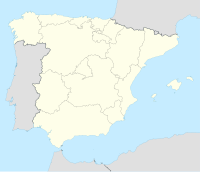Conca de Barberà (wine region)
| Data | |
|---|---|
| Wine region : | Conca de Barberà |
| Country : | Spain |
| Surface: | 5,900 hectares |
| Wine production: | 30,000 liters ( year ) |
Conca de Barberà (Catalan: "Basin of Barberà" ) is a wine-growing region in the north of the Spanish province of Tarragona, Catalonia . The basin got its name from the famous " Barberà " grape variety that is grown in this area. With an area of 5,900 hectares, the wine-growing region has over 20 wineries. A total of 30,000 liters of wine are produced each year. Conca de Barberà has the classification DO (Denominación de Origen).
Geographical location and climate
To the north of the provincial capital Montblanc (Tarragona) lies Conca de Barberà between the low mountain ranges of the Montsant and Priorat. The erosion basin is bounded on the west by the river "Riù Francolí" and the tributary "Anguera" and to the east by the "Ríu Gaiá". The force of erosion created a calcareous, loosened soil. The Mediterranean and dry climate has a slight continental influence, which ensures significant temperature differences between day and night. However, these are very important for the taste of the wines and the quality of the vines.
Typical vines
The most important grape varieties include the Macabeo and Parellada , which traditionally belong to the Cava varieties. Both types are pressed into very pure white wine during processing. Other white grape varieties are Chardonnay , which is also used to produce sparkling wine, and Sauvignon Blanc . The white wine manifested the success of the Conca de Barberà.
The red grape varieties in the growing area include Trepat , Ull de Llebre ( Tempranillo ), Garnatxa , Cabernet Sauvignon , Merlot , Pinot noir and Syrah .
history
Wine has been grown in the Conca de Barberà since the first century AD. In the 12th century, viticulture was transferred to the monasteries, who began to settle in this area. Among other things, there is a strong bond here with the history of the Poblet Monastery . At the end of the 18th century, the wine from Conca de Barberà was widely known and was able to name the USA and many European countries as its major export customers. The vines were attacked by phylloxera towards the end of the 19th century, which severely damaged the plants. To date, no successes like those achieved in the 18th century have been recorded.
Others
The Conca de Barberà carries out two grape harvests per vintage. The grapes, which grow in locations with high solar radiation, are picked four weeks before the main harvest and pressed into very fruity and refreshing white and red wines. This is not intended for storage, but for young use. The wine-growing region is also one of the most formative cava and rosé producers.
supporting documents
- ↑ a b c d DO Conca del Barberà wine-growing region. Retrieved on September 23, 2017 (German).
- ↑ a b espavino.com - Spain - Wine Regions and their Wines: Spanish Wine Regions and their Wines - Spanish Wines (Wine from Spain). (No longer available online.) Archived from the original on September 23, 2017 ; accessed on September 23, 2017 . Info: The archive link was inserted automatically and has not yet been checked. Please check the original and archive link according to the instructions and then remove this notice.
- ↑ a b c d ➤ Conca de Barbera - wine-growing region in Spain, wine and viticulture in Conca de Barbera. Retrieved September 23, 2017 .
- ↑ Conca de Barbera: Delicious red wines from Trepat! Retrieved September 23, 2017 .
